This is a Minox 35 ML 35mm compact camera made by Minox GmbH of West Germany starting in 1985. It was the first model in the Minox 35’s third generation with a redesigned body with a flatter top plate, all new electronics, shutter, and LED viewfinder. Perhaps the biggest change for users today is that this model was the first Minox 35 to use a commonly available 6v PX28 battery. The entire Minox 35 series was in production from 1974 to 2004 spawning as many as 30 different models.
Film Type: 135 (35mm)
Lens: 35mm f/2.8 Minotar coated 4-elements
Focus: 3 feet to Infinity
Viewfinder: Scale Focus with 35mm Projected Brightlines and LED shutter speed readout
Shutter: Electronic Leaf Shutter
Speeds: 1 – 1/500 seconds
Exposure Meter: Coupled SPD Meter with Program and Aperture Priority AE
Battery: 6v PX28 Lithium or Silver Oxide Battery
Flash Mount: Hotshoe with 1/125 flash sync
Weight: 181 grams
Manual: http://www.cameramanuals.org/pdf_files/minox_35ml.pdf
History
Throughout a large part of the 20th century, the name Minox was most commonly associated with a family of extremely compact sub-miniature cameras that were often referred to as “spy” cameras due to their prevalence during the cold war. Minox made the smallest commercially available cameras you could buy and shot 8mm x 11mm exposures on it’s own proprietary film. Despite their small size, Minox cameras were built to a high standard and often had quality lenses and shutters.
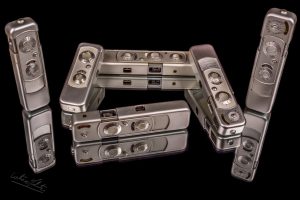
Minox produced a huge number of these sub-miniature cameras starting with the original Riga in 1938 to the Minox EC in 2004. The 8×11 film used by these cameras is still available today.
In 1966, another German company, Franke & Heidecke produced the world’s smallest full frame 35mm camera called the Rollei 35. It was incredibly small at a size of 97 x 32 x 60 mm (WDH) and weighed only 370 grams. The camera’s compact size was a huge achievement, managing to pack in a fully functional full frame camera in a size that was smaller than most half frame 35mm cameras like the Olympus Pen.
The Rollei 35 would remain the smallest 35mm camera until 1973 when Minox would debut the ur-Minox prototype at the 1973 Photokina. The new camera was designed in Vienna, Austria by Professor Richard Fischer and not only was smaller than the Rollei, but it was substantially lighter due to it’s fiberglass reinforced Makrolon body.
The first model in the series, the Minox 35 EL would go on sale in 1974 and would become an immediate success. Offering a smaller and lighter body than the Rollei, it had a list price of $183 which when adjusted for inflation is about $928 today.
The Minox 35 would launch a whole family of at least 30 different compact 35mm full frame cameras all with the same basic formula of a front folding door that covers a retractable 3 or 4 element f/2.8 lens. Later models would offer features like full program auto exposure, auto focus, and optional flash attachments. There would be colored and gold plated special editions, and even some promotional models made of clear plastic and glass.
The Minox 35 ML being reviewed here is considered to be the first in the third generation of Minox 35 models featuring a revised body with a flatter top plate, an entirely new shutter that was said to be more reliable, all new electronics that relied on a modern PX28 6v battery replacing the much harder to find PX27 battery used in all earlier versions, and a new LED viewfinder display. Although still about the same size of earlier models and featuring the same excellent Minotar lens, the 35 ML is a more desirable model today due to the convenience of being able to use a common PX28 battery and a more reliable shutter.
Despite the improvements to the camera and it’s electronics, the list price of $199.95 meant it was not only more expensive than almost every other compact camera, it lacked features like auto focus that by the 1980s many customers had come to expect. It sold in modest numbers and was quickly replaced by simpler models like the MB and AL. By the late 1980s, Minox 35 models seemed to split into economic low end compact cameras, or high end luxury items with features like auto focus and all aluminum cases.
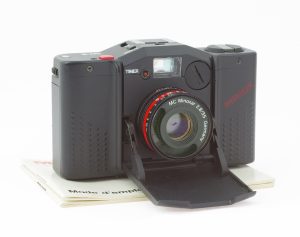
Despite their relative obscurity and high prices, Minox was clearly onto something as they were able to continue the Minox 35 line all the way to 2004 with the GT-S which remains a popular collectors item.
Today, the entire Minox 35 line up is sought after by collectors and users. Some models like the ML are more desirable as they are generally easy to find in good working condition. Many of the earlier models are plagued by non-working electronics and sometimes are DOA even in mint condition. Starting with the ML and on, all models use commonly found PX28 batteries that are available at hardware stores making them one of the more popular models if your goal is to shoot one.
My Thoughts
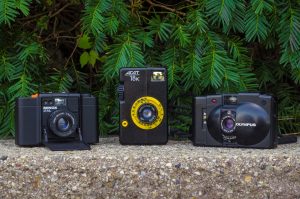
I’ve had a lot of experience with compact cameras lately. The Minox 35 ML follows the Olympus XA2 and Agat 18K which I have recently reviewed, and comes before a few others I have in my review queue.
Like the Agat 18K, this one was a loaner from my friend Adam Paul and he sent it to me with the general description that he knows it’s a great camera, but it’s not one he’ll likely shoot any time soon.
I took the Minox out for it’s inaugural roll in September 2017 around the same time I was shooting the Olympus. While the two cameras are both extremely light weight and compact manual focus cameras, they were both designed for two different ends of the market. I would never suggest the XA2 is a cheap feeling camera, but it never hides the fact that the body is entirely made of plastic. Over time, the sliding clamshell case can become a little erratic in it’s ability to open and close smoothly and the shutter button is a common failure point. The Minox however, feels as sturdy as it likely did the day it was made. All Minox models were high end cameras that sold for a premium when they were new and it really shows with an impressive build quality
Period advertisements of the earlier Minox 35 models often heralded the use of something called Makrolon in the construction of the camera’s body. I had no idea what Makrolon was, so I looked it up.
As best as I can tell, Makrolon is a trademark owned by the German company Bayer, of their line of polycarbonate products. According to Wikipedia:
Polycarbonates are a group of thermoplastic polymers containing carbonate groups in their chemical structures. Polycarbonates used in engineering are strong, tough materials, and some grades are optically transparent. They are easily worked, molded, and thermoformed. Because of these properties, polycarbonates find many applications.
I’ll just summarize my understanding of Makrolon as a “tough sciencey plastic that works well when used to make cameras”.
Unlike the XA2 which I had recently shot, the Minox has a full focus lens. The model I reviewed had distance markings in meters, which meant I had to do some calculations in my head when measuring things out. The manual for the 35 ML linked to above shows the scale in feet, so it’s likely I have a European spec model that somehow made it’s way across the pond at some point in it’s life. But even if you do encounter a metric Minox, don’t worry too much about correct focus distance as the 35mm Minotar lens has a huge depth of field. Like the XA2, the Minox can almost work like a focus free camera in good lighting.

The user’s manual states that setting precise focus is only needed at close focus or when shooting the lens wide open. It goes on to say that with the lens set to f/11 and the right hand ‘f/11’ index mark set to infinity, everything from about 5.5 feet or 1.7 meters will be in focus. At f/16, the entire range of 4 feet or 1.2 meters all the way to infinity is in focus. As a general rule, when shooting in good lighting, with an aperture of f/8 or smaller, set the focus ring to 10 feet, and anything about 6 feet and beyond will be in focus.
As I tend to do with most vintage cameras, I shoot outdoors and in good lighting to try and maximize my depth of field by using apertures f/5.6 and larger. I was a bit ambitious with the 35 ML taking a few risks indoors knowing that even with larger apertures, the 35mm lens afforded me more flexibility than a typical camera with a 50mm lens would.
The Silicon Photo Diode meter on the Minox is well regarded as being extremely accurate. Since this model was designed for modern batteries, there was no risk to the metering system like when adapting a modern in a camera from the “mercury era”. Adam confirmed to me that he trusted the meter on this camera with fresh slide film, so I was free to use whatever film I wanted.
One of my favorite features of the Minox 35 ML is that although it is capable of full program auto exposure, you can override the aperture selection and put it in Aperture Priority mode by rotating the inner most ring around the lens away from “P” to any number between 2.8 and 16. Aperture Priority remains my favorite type of AE as it allows me to control the depth of field while trusting the camera to get everything else correct. It is not common to find a compact camera from the 1980s with Aperture Priority override.

Before using the camera, the first step is to open it. The front door is released by pressing down on the large button on the front edge of the camera in front of the hot shoe. Pushing this release only allows the door to pop open partially. You must manually fold down the door the rest of the way to erect the lens and shutter to the taking position. It’s worth noting that unlike most folding cameras, the Minox does not use any sort of bellows to keep the film compartment light tight. It accomplishes the folding motion through a sliding tube of sorts.
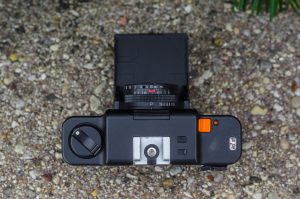
The top plate of the Minox 35 ML starts from left to right with a manual film rewind lever, flash hot shoe in the center, an unlabeled battery check button and back light compensation slider, a bright orange shutter release with cable release socket next to it, and the exposure counter on the far right.
The battery check button is pretty straightforward and when pressed, illuminates a red LED in the viewfinder beneath the “P” indicator, but the back light compensation latch confusingly displays a white on red ‘2x’ mark when slid to the left. The 2x probably means “twice as much light” when in reality means +1 EV. This slider does not automatically reset after taking a photo and will stay in ‘2x’ mode for as long as you leave it in that position.
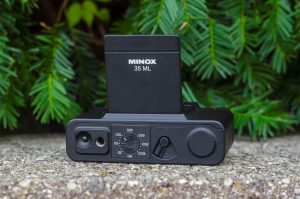
The bottom plate of the camera features a rewind release button that must be held in while rewinding the film, a tripod socket, film speed (for the exposure meter) selector, and the camera back release.
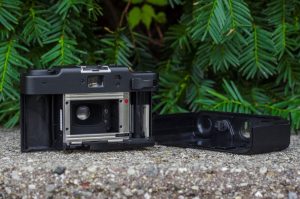
Loading film into the camera requires the entire back to be removed. From there, film loads in from left to right like most other 35mm cameras of the day. The take up spool has two white flaps that the leader can be inserted into to make loading simple. Although not quite as automatic as later cameras, I find this system to be very well designed. Although “quick load” systems existed when this camera was new, it is the lack of those features that allowed Minox to keep the size of the camera as small as possible.
To the right of the viewfinder on the back of the camera is another sliding latch which activates the 10 second self-timer. Like the back light compensation latch, the self-timer does not automatically cancel, so you must slide it back before taking your next photo.
The Minox 35 ML is a double wind camera meaning it requires two strokes to advance one frame of film. The camera does have double exposure prevention without any obvious way to override it. The manual doesn’t mention an override, but on many cameras with this feature, a double image may be obtained by momentarily holding the rewind release button while advancing the camera to the next exposure. I did not try this myself, however.
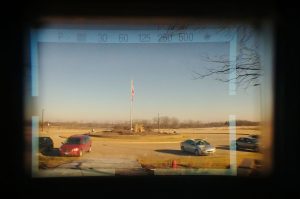
The viewfinder is bright and features a neat, but rather useless shutter speed scale at the top that shows you the selected shutter speed that the auto exposure system has chosen. I say the scale is useless for a couple of reasons.
The first, is that it only functions when the camera is in Aperture Priority mode. When the camera is set to Program mode, a red LED lights under the “P” in the viewfinder no matter what shutter speed is selected. In Aperture Priority mode, you get 6 possible choices. There are 5 speeds for 30, 60, 125, 250, and 500, and a vague “slower than 1/30” setting. The manual warns you that this is a camera shake warning and that it could mean 1/15, 1/5, or even 4 sec. You have no way of knowing.
Even more puzzling is that the camera is capable of infinitely variable shutter speeds, so of the 5 actual numbers displayed, they only light up to whatever is closest to that number. So for example, lets say at a given aperture value, the amount of light detected calls for a shutter speed of 1/200. The shutter will actually fire at 1/200, but the number for 1/250 will be selected. I guess it could be useful to get an approximate value of the shutter speed, but since it’s just an estimation, why even bother at all?
The only other things visible in the viewfinder is a little star in the upper right corner that indicates overexposure at the selected aperture value, and non-parallax corrected frame lines. The frame lines are near the extreme edge of the visible viewfinder, meaning that people with prescription glasses will have a hard time seeing the edges without smooshing your face up against the camera.
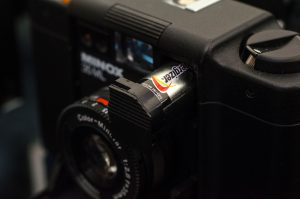
One last warning about the camera is something that it’s owner warned me about and in my opinion is a huge oversight of the design of the camera, which is with a dead or missing battery, the camera can be advanced and the shutter release can be fired, however the shutter will not operate. It is not unusual for an electronic shutter camera to not fire with a dead battery, but on most electronic cameras, the shutter release physically will not do anything with a dead battery. With a dead battery, the Minox sounds and feels like the shutter is firing. There is a click and everything, but the shutter does not open. This is frustrating because with a dead (or missing) battery, you can fire off several frames of film, advancing the film after each press of the shutter release button, without ever capturing a single image. I do not know if this is common among other Minox 35 models, but I really wish the camera had some sort of shutter lock that would prevent this from happening when it doesn’t have any power.
This is a minor annoyance as you really should be diligent about checking the battery power of any camera before using it. With a fresh battery, I found very little to complain about.
My Results
With a pretty good idea of what to expect of the Minox 35 ML, I loaded in a roll of fresh Kodak Gold 200 and went out shooting. Since the camera was so small, I kept it with me in the car doing daily life sort of stuff and shot whatever my eye happened to catch. Since this camera was a loaner, I knew that I could trust the meter so I left it in Program mode for nearly the whole roll, only putting it into Aperture Priority for a few shots.
The Minox 35 ML has a lot of great things going for it for sure. It has a really nice and compact body made out of a polycarbonate material that’s both light weight, strong, and has an “upgraded” feel that’s better than just plain old plastic. The metering system is very good and despite being over 30 years old, handled everything I threw at it. In the gallery above, there are several shots indoors where the camera metered the scene perfectly. Even in the bright sunlit scenes of the train and the train mural, colors are vivid and highlights are not blown out.
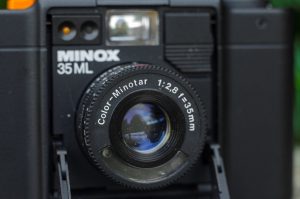
The images shot through the 4-element Color-Minotar lens were excellent. They were sharp across the frame, exhibited no vignetting, softening at the edges, or chromatic aberrations. To be perfectly honest, I don’t know that I would be able to easily differentiate images shot on this camera or a more expensive SLR. It must have been that trait which justified the relatively high price for the Minox 35 ML. Photographers could get images nearly indistinguishable from more expensive cameras, in a compact and portable model.
For it’s compact size, all of the essential controls were easy to reach and didn’t require fiddling with tiny little levers like on some other compact cameras of the era. The viewfinder is large and bright and although I found the LED shutter speed indicators to be of questionable usefulness, when shot in full Program AE mode, you don’t need them.
At a price that is comparable to $469 today, the Minox EL was not a cheap camera and it shows. This was, and still is, an excellent tool that is capable of images as good as much larger SLRs. This was an every day camera for someone who wanted portability without sacrificing quality. I really enjoyed my time with the Minox 35 ML, and despite a few nit picks, I can absolutely recommend this to someone looking for a compact and capable camera.
My Final WordHow these ratings work |
The Minox 35 ML is a premium compact camera. Offering a fully automatic Programmed AE or Aperture Priority AE experience with manual focus and manual film advance, the camera is a hybrid of automation. What the camera lacks in size, it makes up for in excellent build quality, excellent optics, and an excellent meter. These camera represent the absolute best of what a compact 35mm camera is capable of and if you have an opportunity to pick one up, I highly recommend it. | ||||||
| Images | Handling | Features | Viewfinder | Feel & Beauty | History | Age | |
| 2 | 2 | 1 | 1 | 2 | 0 | 0% | |
| Bonus | +1 for the complete package, a camera that is more than the sum of it’s parts | ||||||
| Final Score | 9.0 | ||||||
Additional Resources
http://camera-wiki.org/wiki/Minox_35_ML
http://quirkyguywithacamera.blogspot.com/search/label/Minox%2035ML
http://www.submin.com/35mm/collection/minox/cameras/ml.htm
http://www.theothermartintaylor.com/moveabletype/archives/cameras/000155.html
https://www.lomography.com/magazine/279587-lomopedia-minox-35-ml

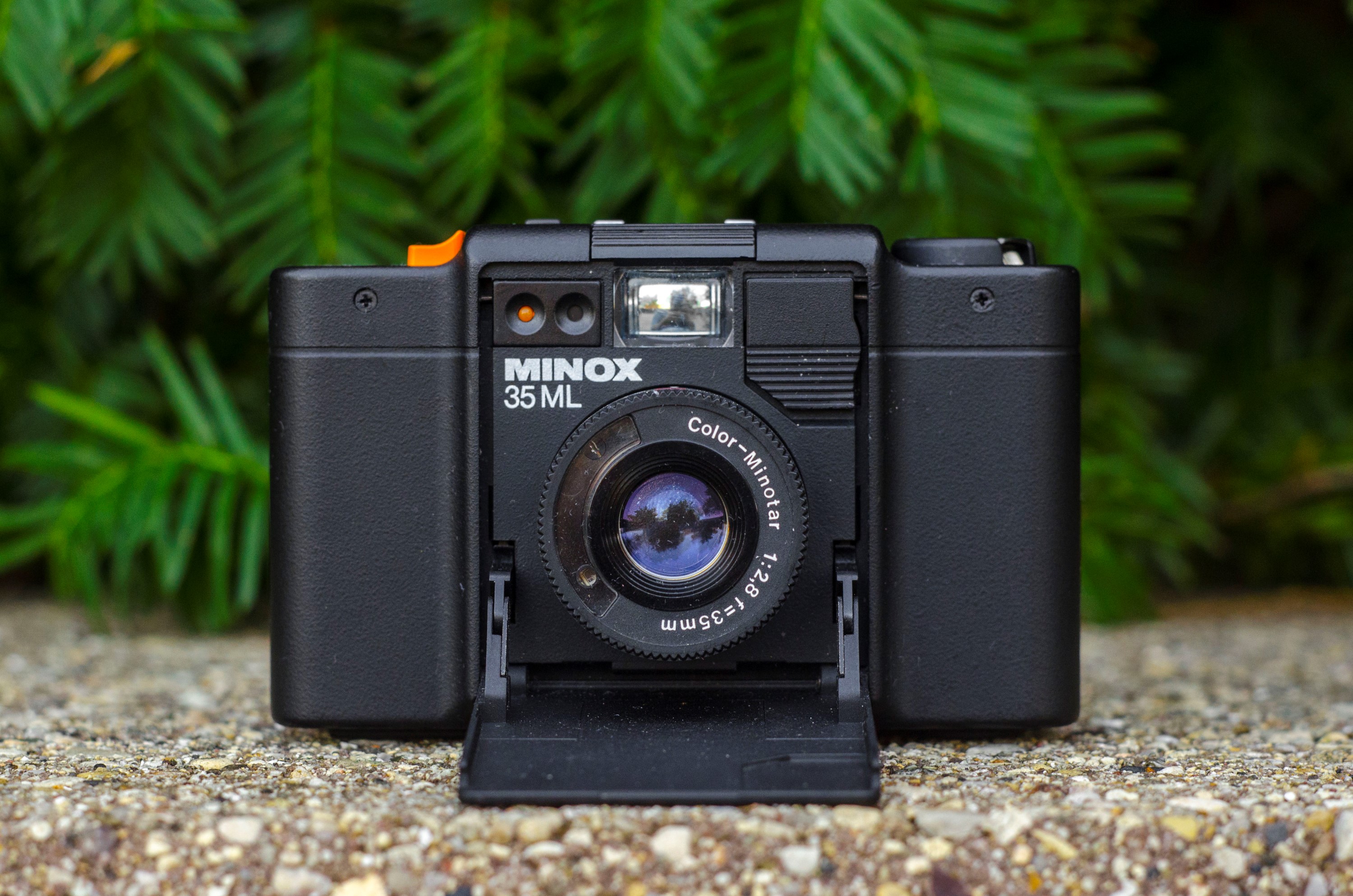
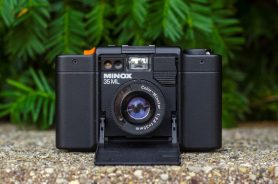
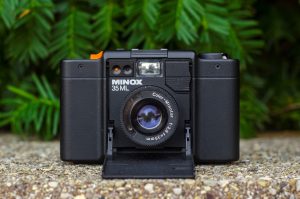
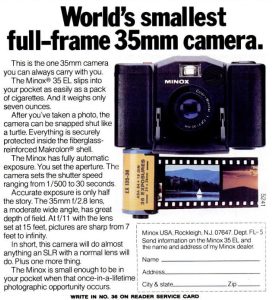












Great research, and a great job of shots with this camera!
From what I can see, the results here are VERY easily distinguishable from a common point and shoot camera, but not as easily distinguished from a more robust and full featured model. The only tell tale sign is how the Minox doesn’t seem to get as much depth in separation of field as other cameras, and its limited bokeh is sort of oddly shaped, as can be seen in the background of your first shot, where the background highlights are almost reminiscent of that in a mirror lens.
The amount of versatility that this camera offers in such a small package has pretty much never been matched, and the lens does a wonderful job of filling the frame with color and contrast, leaving only the skills of distance estimation (and for me: metric conversion) as a helpful prerequisite for making great shots with this little powerhouse.
thank you sir for this useful review!
Thank you for this, I have one, I’m getting ready to put it to work again, I hope it’s OK! I loved it . You have a battery checker, the HUD doesn’t work if no battery. If you weren’t sure about battery you just checked before you took the photo.
I never used the 2x button, I have a filter which doubled the shutter speed to 1000, I used that.
I have the flash too. It was a little bulky but worked great. I had a lot of fun.
Portraits aren’t easy, but I made some beauts. The easiest people shots were “American” ones. Ie legs up.
It taught me to evaluate distances, to start I found a tiny Leica device with mirrors, but found I didn’t need it later .
I have some double exposures, more because sometimes it stuck and you had to open the back, I shall try your tip .
Thank you !
Good article.That so get this camera. Since they came out have always had a MInox 35. Not the most reliable https://www.flickr.com/photos/77437968@N00/16900802350/in/photolist-2jmgywh-rKt2HY-mwssVB . But in the magic sock draw of compact camera joy, it gets out more often than the Contax T, the Nikon Ti , the Minolta TC , the Rollei 35, and the Olympus XA. They all have their charms but none fits the pocket as well , and equals the quality of lens for the seize camera that is the MInox 35 ……when it works
These are superb cameras when they work and my favorite to carry with me when I want a very lightweight and slim camera with a tack sharp lens. The main issue with these is they are unreliable at best. When the shutter stops working you don’t know it until it’s too late because the camera still winds and clicks when you press the shutter button. They can be fixed but you never know when they will fail. Still I own and use and love 5 Minox 35 cameras, two of them being Minox 35 MLs.
I really did like this Minox 35 ML I used for this review, but unfortunately, it was a loaner, so I no longer have it. This is one of those cameras on my “long term wishlist”. I am not actively looking for one, but if I stumble upon one for the right price and good condition, I’d definitely snap it up!